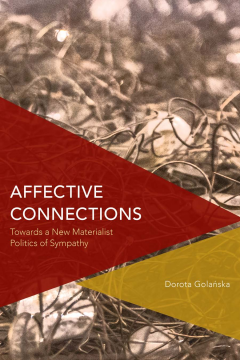
Additional Information
Book Details
Abstract
Inspired by the philosophical framework of Deleuze and Guattari in relation to affect, Affective Connections disavows the dominant oppositional discourse around representation to offer an affirmative approach to perception, cognition and experience. It advances a new materialist concept of synaesthetic perception, where synaesthesia is understood as a union of senses. This idea offers a new figuration for thinking about our cognition, exploring the role of embodied experience and the agency of matter in the production of knowledge.
Looking at a number of memorials, memory sites and artworks relating to the Holocaust the book uses this idea of synaesthetic perception to explore trauma, memory and the production of art in relation to painful memories. In doing so, it demonstrates that modes of interacting with the past and encountering the lived experience of trauma can trigger a deeper understanding of these events and produce more complex forms of affective connections. It proposes a shift away from empathy towards sympathy (understood in new materialist terms), not just as a sentimental response to trauma but as an affective notion that allows for a more comprehensive grasp of experiences of discrimination, exclusion, suffering, or pain.
Dorota Golanska is Assistant Professor at the Department of American Studies and Mass Media at the University of Lodz, Poland
Table of Contents
| Section Title | Page | Action | Price |
|---|---|---|---|
| Affective Connections | Cover | ||
| Contents | vii | ||
| Acknowledgments | ix | ||
| Preface | xiii | ||
| Introduction: Seeing Differently—Introducing a New Materialist Perspective | 1 | ||
| From Negation to Affirmation | 1 | ||
| New Materialism and the “Material Turn” | 2 | ||
| The Twilight of Ocularcentrism | 6 | ||
| Problems with Representation | 12 | ||
| Seeing Differently: New Materialism’s Methodological Orientation | 18 | ||
| About the Book | 21 | ||
| 1 Affect/Discourse: Towards a Synaesthetic Synthesis | 29 | ||
| Illogical Perception: An Introduction | 29 | ||
| Emotions and Affects | 31 | ||
| Embodied Affectivity | 37 | ||
| Memorial Art | 41 | ||
| Beyond Representation—New Materialism and the Arts | 47 | ||
| Synaesthetic Perception | 53 | ||
| The Work of (Memorial) Art: Concluding Remarks | 59 | ||
| 2 Memory Sites: Remembering through Materiality | 63 | ||
| Material Memories of Material Places: An Introduction | 63 | ||
| Remembering Today: Materialization of Memory | 65 | ||
| Approaching “Dark Attractions”: Motivations, Perceptions, Experiences | 71 | ||
| New Museums and Questions of “Authenticity” | 79 | ||
| Importing Trauma: The Holocaust Memory in the United States | 82 | ||
| Past in the Present Tense: The Israeli Memory of the Holocaust | 90 | ||
| Shameful Memories: Remembering the Shoah in the German Context | 98 | ||
| The Mattering of Matter: Concluding Remarks | 105 | ||
| 3 Memory and Trauma: The Unspeakable | 113 | ||
| Entangled Memories: An Introduction | 113 | ||
| Approaches to Trauma: An Overview | 115 | ||
| Traumatic Memory, or a Haunting Past | 119 | ||
| Transmission of Trauma | 125 | ||
| Trauma and the Arts | 129 | ||
| 2146 Stones against Racism (Jochen Gerz, 1993) | 132 | ||
| The Memorial to the Murdered Jews of Europe (Peter Eisenman, 2005) | 136 | ||
| Gravity (Richard Serra, 1993) | 140 | ||
| Bodily-Discursive Encounters: Concluding Remarks | 143 | ||
| 4 Rhythms and Movements: Sensations, Becomings, Flows | 147 | ||
| Constant Movement: The Body as a Verb | 147 | ||
| Thinking (through the) Sensuous Bodies | 149 | ||
| The Rhythm of Un/Learning—A Permanent Vibration | 154 | ||
| Synaesthetic Encounters with Memorial Installation Art | 160 | ||
| Yad Layeled (Moshe Safdie, 1987) | 161 | ||
| The Garden of Exile (Daniel Libeskind, 2001) | 164 | ||
| Shalekhet (Menashe Kadishman, 2001) | 167 | ||
| The Drowned and the Saved (Richard Serra, 1992/1997) | 170 | ||
| The Logic of Relationality: Concluding Remarks | 172 | ||
| 5 Affective Connections: Feminist Politics of Sympathy | 177 | ||
| From Encounters with Art to Feminist Knowledge Production | 177 | ||
| Approaching “Sympathy” through a Feminist Lens | 180 | ||
| Losing Oneself: Affecting and Being Affected | 186 | ||
| The Logic of Connectivity—The New Materialist Politics of Sympathy | 192 | ||
| Passivity and Response-Ability: The Risks of Exposure | 199 | ||
| Material-Semiotic Connections: Concluding Remarks | 204 | ||
| Coda | 209 | ||
| Bibliography | 223 | ||
| Index | 245 |
